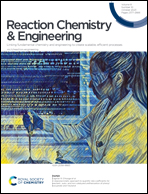Photocatalytic degradation of methyl orange by a diethylenetriamine modified chitosan/bentonite composite†
Abstract
In this study, a novel organic composite photocatalyst (CCS/Bent-DETA) was synthesized by a sol–gel method to degrade methyl orange (MO) under UV light irradiation. The structure, morphology and optical properties of CCS/Bent-DETA were investigated by field emission scanning electron microscopy (FESEM), Fourier transform infrared spectroscopy (FTIR), UV-visible spectrophotometry (UV-vis DRS), photoluminescence (PL), electrochemical impedance spectroscopy (EIS), electron spin resonance spectroscopy (ESR) and X-ray photoelectron spectroscopy (XPS). The effects of pH value, catalyst dosage, the initial concentration of methyl orange, photocatalytic time, and regeneration on the photocatalytic degradation efficiency of MO were studied. The results indicated that CCS/Bent-DETA could reach its optimum performance at pH 2.0, where the removal rate of MO is 100% after 120 min reaction. Adsorption isotherms, thermodynamics, and kinetics with corresponding model fitting were discussed, which suggested that monolayer and chemical adsorption dominated in the adsorption process. Hydroxyl radicals (˙OH) and superoxide radicals (˙O2−) are the main active substances in photodegradation. The reaction process is consistent with the quasi-first-order kinetic model, and the material has good stability and regeneration potential. This study provided theoretical foundation for the large-scale application of chitosan/bentonite photocatalytic materials for the treatment of industrial dyeing wastewater.



 Please wait while we load your content...
Please wait while we load your content...